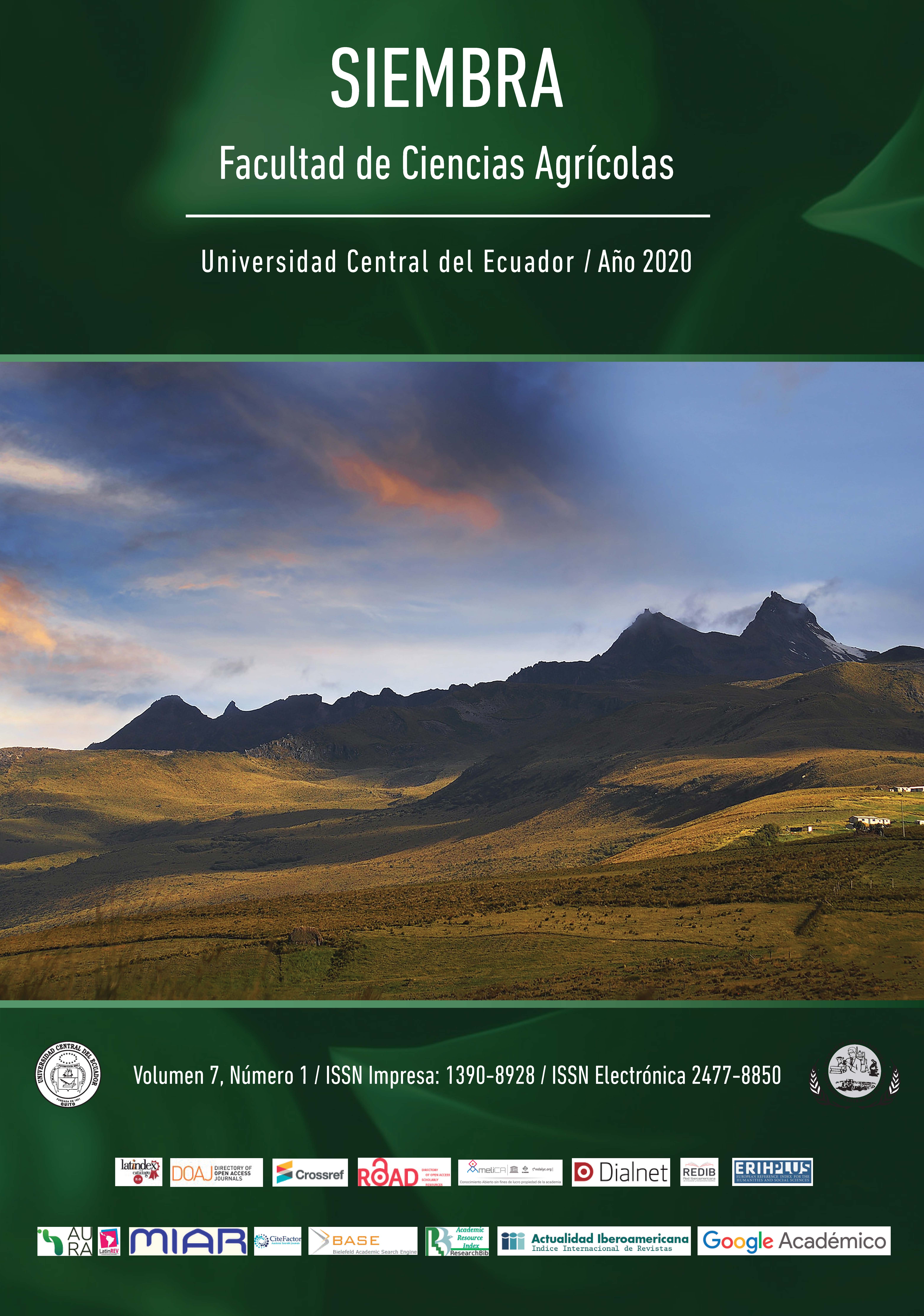evelopment and yield of zucchini and lettuce under living mulches in Cuenca, Ecuador
Main Article Content
Abstract
Keeping soils covered through living mulches is one of the most widely reported strategies to reduce the risk of soil erosion on sloped lands. Nevertheless, soil covers application is not always compatible with the agronomic requirements of vegetable crops. Here, we assess the effect of two living mulches on development and yield of zucchini and lettuce, these crops are typically cultivated in peri-urban systems around Cuenca (Ecuador). A randomized complete block design with 5 replications and three treatments (clover mulch, managed spontaneous natural growth mulch and control) was used. Results shown that yield crops on some mulches are similar yields of those uncovered traditional crops systems. However, implementing and maintaining these mulch crops required more economic resources and labor than uncover traditional crops. These result help identify potential limitations for the commercial implementation of living mulches in vegetable crops under Cuenca conditions and highlight the need to conducts local evaluations of soil conservation strategies.
Downloads
Metrics
Article Details

This work is licensed under a Creative Commons Attribution-NonCommercial 4.0 International License.
The authors who publish in Siembra know and accept the following conditions:
- Authors retain the copyright and grant Siembra the right of first publication of the work, under the Creative Commons Attribution License. Third parties are allowed to use what has been published as long as they refer to the author or authors of the work and its publication in this journal.
![]() This content is licensed under a Creative Commons Attribution-Noncommercial 4.0 International (CC BY-NC 4.0).
This content is licensed under a Creative Commons Attribution-Noncommercial 4.0 International (CC BY-NC 4.0).
- Authors maintain the copyright and guarantee Siembra the right to publish the manuscript through the channels it considers appropriate.
- Authors may establish on their own additional agreements for the non-exclusive distribution of the version of the work published in Siembra, acknowledging their initial publication in the same, such as in institutional repositories.
- Authors are authorized to disseminate their work electronically once the manuscript is accepted for publication.
References
Abdul-Baki, A. A., Stommel, J. R., Watada, A. E., Teasdale, J. R., & Morse, R. D. (1996). Hairy Vetch Mulch Favorably Impacts Yield of Processing Tomatoes. HortScience, 31(3), 338-340. https://doi.org/10.21273/HORTSCI.31.3.338
Blanco-Canqui, H., & Lal, R. (2009). Crop residue removal impacts on soil productivity and environmental quality. Critical reviews in plant science, 28(3), 139-163. https://doi.org/10.1080/07352680902776507
Brandsæter, L. O., Netland, J., & Meadow, R. (1998). Yields, Weeds, Pests and Soil Nitrogen in a White Cabbage-Living Mulch System. Biological Agriculture & Horticulture, 16(3), 291-309. https://doi.org/10.1080/01448765.1998.10823201
Costello, M., & Altieri, M. (1994). Livina mulches suppress aphids in broccoli. California Agriculture, 48(4), 24–28.
Deguchi, S., Shimazaki, Y., Uozumi, S., Tawaraya, K., Kawamoto, H., & Tanaka, O. (2007). White clover living mulch increases the yield of silage corn via arbuscular mycorrhizal fungus colonization. Plant and Soil, 291(1), 291-299. https://doi.org/10.1007/s11104-007-9194-8
FAO. (2005). Final Report of the Project “Global Inventory, Reference Materials and Food, Safety Training Programme for Improving the Quality and safety of Fresh Fruits and Vegetables". Obtenido de: http://www.fao.org/ag/agn/pfl_report_en/it.html
Galloway, B. A., & Weston, L. A. (1996). Influence of Cover Crop and Herbicide Treatment on Weed Control and Yield in No-Till Sweet Corn (Zea mays L.) and Pumpkin (Cucurbita maxima Duch). Weed Technology, 10(2), 341-346.
Harden, C. (1988). Mesoscale Estimation of Soil Erosion in the Rio Ambato Drainage, Ecuadorian Sierra. Mountain Research and Development, 8(4), 331-341. https://doi.org/10.2307/3673556
Hartwig, N. L., & Ammon, H. U. (2002). Cover Crops and Living Mulches. Weed Science, 50(6), 688-699. Recuperado de JSTOR.
Hooks, C. R., & Johnson, M. W. (2004). Using undersown clovers as living mulches: Effects on yields, lepidopterous pest infestations, and spider densities in a Hawaiian broccoli agroecosystem. International Journal of Pest Management, 50(2), 115-120. https://doi.org/10.1080/09670870410001663462
Inbar, M., & Llerena, C. A. (2000). Erosion Processes in High Mountain Agricultural Terraces in Peru. Mountain Research and Development, 20(1), 72-79. https://doi.org/10.1659/0276-4741(2000)020[0072:EPIHMA]2.0.CO;2
Lal, R. (1997). Mulching effects on runoff, soil erosion, and crop response on alfisols in Western Nigeria. Journal of sustainable agriculture, 11(2-3), 135-154. https://doi.org/10.1300/J064v11n02_10
Lal, R. (1998). Soil erosion impact on agronomic productivity and environment quality. Critical reviews in plant sciences, 17(4), 319-464. https://doi.org/10.1080/07352689891304249
Li, Q., Li, H., Zhang, L., Zhang, S., & Chen, Y. (2018). Mulching improves yield and water-use efficiency of potato cropping in China: A meta-analysis. Field crops research, 221, 50-60.
Kołota, E., & Adamczewska-Sowińska, K. (2013). Living Mulches in vegetable crops production: Perspectives and limitations (A review). Acta Scientiarum Polonorum-Hortorum Cultus, 12(6), 127–142.
Masiunas, J. B. (1998). Production of Vegetables Using Cover Crop and Living Mulches—A Review. Journal of Vegetable Crop Production, 4(1), 11-31. https://doi.org/10.1300/J068v04n01_03
Pelosi, C., Bertrand, M., & Roger-Estrade, J. (2009). Earthworm community in conventional, organic and direct seeding with living mulch cropping systems. Agronomy for Sustainable Development, 29(2), 287-295. https://doi.org/10.1051/agro/2008069
Qian, X., Gu, J., Pan, H., Zhang, K., Sun, W., Wang, X., & Gao, H. (2015). Effects of living mulches on the soil nutrient contents, enzyme activities, and bacterial community diversities of apple orchard soils. European Journal of Soil Biology, 70, 23-30. https://doi.org/10.1016/j.ejsobi.2015.06.005
Roger-Estrade, J., Anger, C., Bertrand, M., & Richard, G. (2010). Tillage and soil ecology: Partners for sustainable agriculture. Soil and Tillage Research, 111(1), 33-40. https://doi.org/10.1016/j.still.2010.08.010
Theunissen, J., & Schelling, G. (1998). Infestation of leek by Thrips tabaci as related to spatial and temporal patterns of undersowing. BioControl, 43(1), 107-119. https://doi.org/10.1023/A:1009986917903





